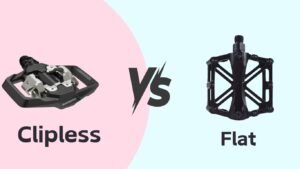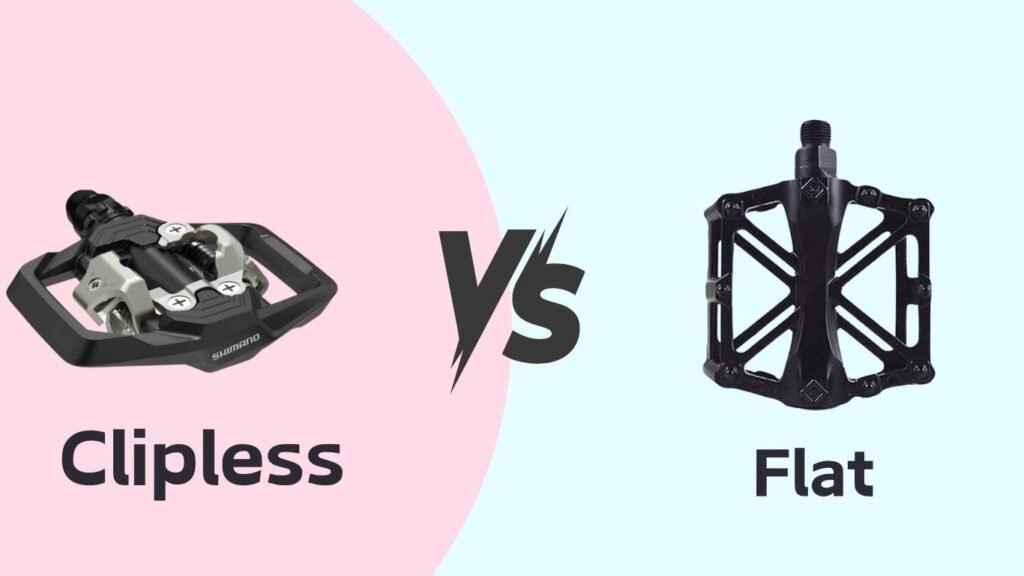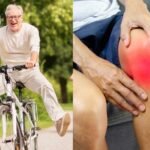As a new mountain biker, you may have many questions—one of the most common being how to choose the right mountain bike pedal. Or which one is right for me, Clipless vs Flat Pedals?
In this guide, we’ll take a look at both of these mtb pedal types so that, in the end, you can make a decision on which one you should choose based on your riding style, personal preference, and other important factors.
Also read: How to Choose the Perfect MTB Helmet
What Are Clipless and Flat Pedals?

Before discussing the advantages and disadvantages of clipless and flat pedals, let’s take a moment to understand their basics.
Clipless Pedals: Despite being called clipless pedals, they interestingly involve “clipping in.” But you’ll need special types of mountain biking shoes to be equipped with their cleats that attach to the pedals.
Then, the combination of those shoes and clipless pedals will keep your feet in the same place while giving you more stability and allowing you to feel more connected.
Flat Pedals: For flat pedals, you can wear any type of shoes, even sneakers, as they’re traditional pedals designed for simplicity. As the name suggests, “Flat pedals” come with flat surfaces, which help you easily hop on and off the bike.
The Case for Flat Pedals

Flat pedals are the starting point for most beginners as they don’t know about clipless pedals. Plus, When you buy new mountain bikes, most of them come with flat pedals.
That’s why beginners naturally start with them. Besides this, they are also good for all types of riding conditions. However, let’s look at some of their pros.
Pros of Flat Pedals:
Ease of Use: These pedals are very simple, and no complicated mechanism is involved. You can simply hop on and start pedaling when you want to go without even worrying about getting your feet clipped in. So, this thing makes flat pedals perfect for quick rides and casual trails.
Freedom to Bail: As they are flat, you can quickly put a foot down to regain balance. Especially when you encounter tricky terrain (you’ll have to do it frequently).
Improved Technique: When you have flat pedals, they will force you to develop better techniques. For example, with flat pedals, you have to focus on proper pedal strokes and lift your feet at the right time during any jump. This technique will help you improve your overall mountain biking skills.
Versatility: Flat pedals are compatible with all types of mountain biking shoes or footwear. So you don’t have to waste time thinking about what to wear for mountain biking.
Cons of Flat Pedals:
Less Secure: You can not clip into flat pedals, which is why they are not really secure. Your feet might slip off the pedals when you try to ride aggressively, for example, on a steep descent and while navigating technical trails.
Efficiency Loss: You might also lose the pull-up ability. It’s the opposite of a clipless pedal system.
Who Should Choose Flat Pedals?
There are three reasons why you need to choose flat pedals.
The first one is if you are a new mountain biker who is just starting and you want to boost your confidence; in such a case, you can go with flat pedals and ride casually while learning mountain biking techniques and skills.
Secondly, if you often ride on technical trails with frequent stops and starts, you can still go with flat pedals for better adjustments.
Lastly, if you want freedom and flexibility, then you still need to go with flat pedals, and you won’t have to lock your feet with these pedals.
Also read: Basic Mountain Biking Etiquette for All Riders
The Case for Clipless Pedals

Clipless pedals are designed for more serious riders; they will make you feel more connected while giving you an efficient riding experience. Most riders often prefer them for cross-country riders and racers and to maximize their performance.
Pros of Clipless Pedals:
Better Power Transfer: When you are using clipped pedals, you can easily pull up on them as well as push them down, and this will result in giving you more power during each pedal stroke, which will conserve energy and improve your efficiency. So, for a longer ride, it’s a good thing.
Enhanced Control: These pedals keep your feet locked in one place, which provides better stability and control, which you especially need on technical terrain. Plus, this will help you on sharp turns, drops, and rocky sections of any trail.
Smooth Pedaling: You won’t have to worry about slipping off because your feet will get attached in one place. It’s useful if your main focus is on techniques and performance.
Improved Climbing: These pedals are also ideal for steep climbs, where every bit of your power will be counted. Pulling up these pedals will help you maintain traction and power output, which makes it ideal for uphill riding.
Cons of Clipless Pedals:
Learning Curve: As I have mentioned earlier, flat pedals are very simple, and most beginners start with them. However, when you switch to clipless pedals, it might be frustrating to get fit with these pedals. Sometimes, it may even lead to falls, but with time, you’ll get comfortable with them.
Less Freedom: Once you have slipped in, it will be hard to adjust your foot position or put your feet down for an emergency. Because your feet will be stuck with the pedals.
Specialized Shoes Required: When you want to use clipless pedals, you will need special mountain biking shoes that are designed for your cleats, which means you will have to pay more money for that. Plus, you will also need to learn how to adjust and position the cleats for more comfort.
Who Should Choose Clipless Pedals?
Clipless pedals are ideal if you love cross-country or long-distance rides where you need better efficiency and power. These pedals also provide you with more control for technical trails and downhill ridings.
If you often ride on these types of trails, I suggest you choose them. But make sure you are willing to invest time in learning and money for suitable shoes for your clipless pedals.
Also read: Which is the best, full Suspension vs. Hardtail Mountain Bike?
Factors to Consider When Choosing Pedals

There are actually four factors that you want to keep in mind while making your decision; let’s discuss them one by one:
1. Riding Style
If you want to tackle technical terrain with very few stops, then flat pedals may be more forgiving.
For long, steady rides like cross country, clipless pedals are generally considered better as they provide efficiency.
If you often want to ride on downhill trails, then choosing flat pedals is a good choice, as you can adjust them quickly during fast descents.
2. Skill Level
Most new riders with fewer skills feel more comfortable starting with flat pedals because of their simplicity and flexibility.
On the other hand, Intermediate and advanced bikers prefer clipless pedals for better performance.
Also read: 4-Week Mountain Bike Training Program to Improve Skills and Performance
3. Comfort and Confidence
Being a first-time user, it’s natural to get nervous about being clipped in. In such a case, either you’ve to show some courage or consider using flat pedals.
4. Terrain
Flat pedals are ideal for riding a mountain bike on terrain that has too many rocks, roots, jumps, etc., because you’d have to adjust your feet many times, especially when you’re an advanced rider, so with clipless pedals, it might be hard for you to adjust.
But clipless pedals are good for smooth climbs and flowy trails, as they’ll give you more consistent power and traction.
Make the Transition: Tips for Switching Pedals
If you already have a clipless or flat pedal and you want to replace it, then you should keep these things in mind.
Flats to Clipless:
Practice Clipping In and Out: Initially, it’s kind of weird to shift to clipless pedals from flat ones. However, it’s not completely impossible; you just want to build up a habit, and for that, you can ride a bike with clipless pedals in a neighboring area like a park.
Start with Easy Trails: After switching to a clipless pedal from a flat one, you should directly jump onto technical trails. You should first focus on building confidence and habits to tackle these trails.
Loosen the Tension: Initially, you can lose the tension of your clipless pedal to make it easier to release the tension.
Clipless to Flats:
Invest in Good Shoes: One of the most common problems that people face with flat pedals is that they don’t provide good grip, which causes feet to often slip from the pedals. That’s why when you are using flat pedals, you want to invest in good shoes for mountain biking that have sticky soles.
Practice Pedal Technique: Even flat pedals don’t have cleats, but you still want to place the foot in the right place to maintain balance and stability.
Relearn Foot Positioning: When you switch from clipless pedals to flat pedals, you might feel quite strange, especially in the beginning. So please learn foot positioning and balance for a better riding experience.
Also read: Mountain Bike Pre-Ride Checklist: 10 Essential Tips for a Safe Ride
Can’t Decide? Consider Hybrid Pedals
Now that you know everything about choosing flat pedals and clipless pedals. However, if you are still confused between these pedal types, then I would suggest you go with hybrid pedals because they offer both features.
For example, in hybrid pedals, one side is flat, which is similar to flat pedals, and the other side is clipless, which you can use for more technical riding. That’s why you can consider going with hybrid pedals for more versatility.
Besides this, you can also have both types of pedals, clipless and flat ones, and based on what terrain you want to ride, you can assemble pedals on your bike.
Final Thoughts: Which Pedals Are Right for You?
At the end of the day, the right mountain pedal type depends on your personal preference and your own goal and comfort. You first want to determine what type of trail you want to ride often.
For example, if you are a beginner and want to ride on simple roads and trails, then you should use flat pedals.
But you should go with clipless pedals for more power efficiency and control, which we need on technical trails. On the other hand, if you are confused about choosing between flats and clipless, you can consider going with hybrid pedals. They come with both features.
What Are the Main Differences Between Clipless and Flat Pedals for Mountain Biking?
Clipless pedals come with a cleat system, which riders attach to their shoes to secure their feet during pedaling, and they provide more power and control.
On the other hand, flat pedals don’t require any special types of shoes and allow bikers to easily move their feet on and off the pedal. They are good for better mobility and comfort during technical rides, but you won’t get enough power and control like clipless.
Are Clipless Pedals Better Than Flat Pedals for Beginners?
Well, it depends on who you are and what your skill level and experience with mountain biking.
Generally, if you are a beginner, then yes. Flat pedals are better for you because they allow you to quickly put your foot down from the pedal while giving you stability and confidence.
On the other hand, if you are an intermediate or a pro-level biker with more experience and want to ride on technical terrains or some hard trails, you will need more power and control. In such a case, yes, clipless pedals are better than flat pedals.
Now you know that mtb pedal types depend on your riding style and your personal preference. So, clipless is better for advanced, and flat is better for beginners and casual riding.
How Do I Choose Between Clipless and Flat Pedals for My Riding Style?
Choosing the right pedal type based on your riding style is pretty simple. For example, if you often ride on downhill trails where you need to respond quickly, then go with flat pedals, but if you want more power and want to enjoy cross-country rides, then you should go with the clipless pedal.
However, besides this, I would also suggest you check both of them, maybe. You can find a suitable pedal after taking a test ride while using both of them (see, in your friend circle, if any of your friends have a different pedal than yours)
What Are Some Tips for Transitioning from Flat Pedals to Clipless Pedals?
When you are switching pedals (flat to clipless), you need to practice on safe terrains. Besides this, you need to adjust the tension settings on the pedals to the easiest release level.
Transition entirely to clipless pedals right away; it might take a week or two to build the habit.
But make sure not to transition entirely to clipless pedals right away. It will sometimes take a week or two to build a habit.
Meanwhile, You want to practice unclipping well before stopping, before you stop. Besides this, you can also consider using one clipless and another flat pedal while you are developing a habit.

Ali is the founder of Mountain Bike Insider and an passionate rider with years of hands-on experience in mountain biking. From testing gear to exploring trails, Ali writes based on real riding knowledge to help others make smart, safe, and enjoyable biking choices. Every guide is built on research, personal use, and a passion for the sport.







